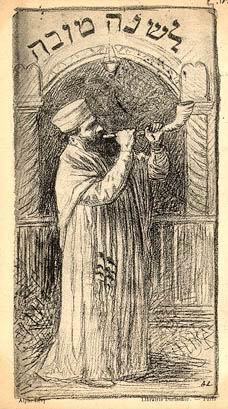Shofar
Shofar is an ancient musical horn typically made from a ram's horn, used for Jewish religious purposes. The shofar is most prominently associated with Rosh Hashanah (the Jewish New Year) and Yom Kippur (the Day of Atonement), two of the most sacred days in the Jewish calendar. Its sound is meant to awaken the listeners from their slumbers and alert them to the coming judgment.
Origins and History[edit | edit source]
The origins of the shofar can be traced back to biblical times, with its first mentioned use in the Book of Exodus during the revelation at Mount Sinai. The shofar was sounded to announce the presence of God and to gather the Israelites together. Over the centuries, its use has been codified within Jewish law (Halakha) and tradition. The shofar is also mentioned in connection with the Jubilee year, in which it was used to signal the release of slaves and the return of lands.
Design and Sound[edit | edit source]
A shofar is made from the horn of a ram or other kosher animals, excluding bovine species. The process of making a shofar involves cleaning, shaping, and sometimes polishing the horn. It has a distinctive sound that varies depending on its size, shape, and the skill of the blower. There are three primary sounds made by the shofar: Tekiah, a long single blast; Shevarim, a series of three short blasts; and Teruah, a rapid series of nine staccato notes.
Religious Significance[edit | edit source]
The shofar holds profound religious significance in Judaism. It is a symbol of repentance, freedom, and the spiritual renewal that comes with the New Year. The sounding of the shofar on Rosh Hashanah is a commandment (mitzvah), and it is also blown at the conclusion of Yom Kippur, marking the end of the fast and the sealing of the Book of Life. In addition, the shofar is associated with the Messiah's coming and the future redemption of the Jewish people.
Contemporary Use[edit | edit source]
Today, the shofar continues to be an integral part of Jewish religious ceremonies, particularly during the High Holy Days of Rosh Hashanah and Yom Kippur. It is also used in some modern Jewish wedding ceremonies and other religious events. The sound of the shofar, with its deep, resonant tones, serves as a powerful call to reflection, repentance, and renewal for Jews around the world.
See Also[edit | edit source]
Search WikiMD
Ad.Tired of being Overweight? Try W8MD's physician weight loss program.
Semaglutide (Ozempic / Wegovy and Tirzepatide (Mounjaro / Zepbound) available.
Advertise on WikiMD
|
WikiMD's Wellness Encyclopedia |
| Let Food Be Thy Medicine Medicine Thy Food - Hippocrates |
Translate this page: - East Asian
中文,
日本,
한국어,
South Asian
हिन्दी,
தமிழ்,
తెలుగు,
Urdu,
ಕನ್ನಡ,
Southeast Asian
Indonesian,
Vietnamese,
Thai,
မြန်မာဘာသာ,
বাংলা
European
español,
Deutsch,
français,
Greek,
português do Brasil,
polski,
română,
русский,
Nederlands,
norsk,
svenska,
suomi,
Italian
Middle Eastern & African
عربى,
Turkish,
Persian,
Hebrew,
Afrikaans,
isiZulu,
Kiswahili,
Other
Bulgarian,
Hungarian,
Czech,
Swedish,
മലയാളം,
मराठी,
ਪੰਜਾਬੀ,
ગુજરાતી,
Portuguese,
Ukrainian
Medical Disclaimer: WikiMD is not a substitute for professional medical advice. The information on WikiMD is provided as an information resource only, may be incorrect, outdated or misleading, and is not to be used or relied on for any diagnostic or treatment purposes. Please consult your health care provider before making any healthcare decisions or for guidance about a specific medical condition. WikiMD expressly disclaims responsibility, and shall have no liability, for any damages, loss, injury, or liability whatsoever suffered as a result of your reliance on the information contained in this site. By visiting this site you agree to the foregoing terms and conditions, which may from time to time be changed or supplemented by WikiMD. If you do not agree to the foregoing terms and conditions, you should not enter or use this site. See full disclaimer.
Credits:Most images are courtesy of Wikimedia commons, and templates, categories Wikipedia, licensed under CC BY SA or similar.
Contributors: Prab R. Tumpati, MD






